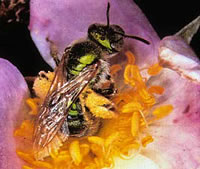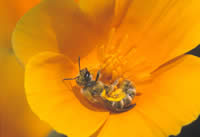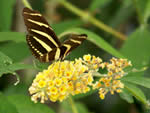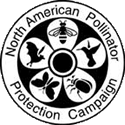USDA Forest Service Celebrating Wildflowers
|
|
|
Halictid Bees
By Vince Tepidino Many students of pollination like to shine a spotlight on specialized pollinators, species that collect pollen from flowers of a few kinds of plants. Examples of such "spotlighting" can be seen in other Pollinator-of-the-Month features such as those about globe mallow bees, squash bees, and pollen wasps. Such examples seem to pique our sense of wonder and perhaps even satisfy our sense of morality ("Gosh, that pollinator and that plant are locked together in monogamy!"). However, no less wonderful are the many other bee species, especially in the family Halictidae (sweat bees), which seem to be "anti-specialists". To paraphrase the early 20th century humorist Will Rogers, they have never met a flower they did not like, and they rarely find one whose pollen or nectar is unyielding. Such generalists visit a wide variety of flowers and often seem to do so indiscriminately. Variety seems to be the spice of their foraging lives. The gorgeous metallic-green sweat bee (genus Agapostemon) in the picture to the right was photographed visiting a wild rose flower on the Wyoming prairie, but she could as readily have been snapped visiting any of five or even ten other flower species on that single foraging trip. It is hardly all fun and games for generalized foragers. Generalization presents problems to the plants that seek to manipulate flower visitors in the pollination game, as well as to the flower visitors themselves. Plants, after all, "want" their flower visitors to confine their visits to flowers of the same species, otherwise their pollen stands a good chance of being deposited on stigmas of other species of flowers, and therefore wasted. The more different kinds of flowers visited on a foraging trip, the lower the chances that any pollination will occur. What's a plant to do? There are many possible "remedies", all of which have probably been "tried" by plants over evolutionary time. Only a few can be mentioned here. One is to seize a part of the blooming period that is less crowded with competitors, thereby increasing the likelihood that consecutive flower visits will be to the same species. For example, natural selection might favor shedding pollen at a time during the season and/or during the day when competition for pollinators is less intense. Selection might also favor morphological modifications in stamens or anthers that place pollen on a particular spot of the insect body that is less likely to compete for carrying or deposition space with pollen of other species.
There are also potential problems for the generalist foragers themselves. One difficulty is metabolizing the contents of pollen grains of different plant species. While pollen grains contain most of the nutrients required by adult bees to mature and rear their offspring, including proteins, starches, fats, and vitamins, plant species are by no means uniform in their pollen constituents. Indeed, pollen grains of some species contain toxic compounds. Thus, digesting pollen from many flower species, as generalists must do, may require more sophisticated metabolic and detoxification systems than possessed by bees that specialize. Another problem for generalist foragers is learning how to manipulate flowers of many plant species, each unique in floral morphology. The behavioral repertoire required to extract pollen and nectar from flowers differs for each plant species. Dealing with several flower types contemporaneously is not easy for small-brained insects to learn. Several studies have shown that workers of social bees such as honeybees and bumblebees forage less efficiently the more flower types they visit. Social bees solve this problem by having individual workers specialize on different plant species, rather than generalize. The hive is thereby, generalized in its flower diet. In contrast, in halictids, even though many species display rudimentary social behavior, individual foragers are the generalists. Learning in halictid bees has not been studied, but their ability to forage indiscriminately may signal that they are the unrecognized geniuses of the bee world. |
|
| NOTE: PDF format links require the Adobe Acrobat Reader to view. | |
| top | Disclaimers | FOIA | Privacy Policy | Quality of Information | Photo Credits & Use |
Location: http://www.fs.fed.us/wildflowers/pollinators/pollinator-of-the-month/halictid_bees.shtml
Last modified: Tuesday, 20-May-2008 15:55:57 EDT





